International Finance: Evaluating Bell Beijing's Business in China
VerifiedAdded on 2023/04/21
|11
|2508
|475
Report
AI Summary
This report analyzes the international finance strategies for Bell Beijing, a language school established in Beijing, China. It addresses various aspects including exchange rate systems in Australia and China, tax implications, currency risk management, and financial instruments for mitigating risks. The report discusses the impact of exchange rate movements on the company's profitability, the role of financial markets, and funding strategies. It also examines concerns raised by banks regarding the company's ability to service loans due to currency devaluation and suggests using futures contracts for risk mitigation. Furthermore, the report explores growth strategies for the business, considering both organic and inorganic growth approaches, and identifies potential challenges in achieving sustainable growth. This document is available on Desklib, a platform providing study tools and resources for students.
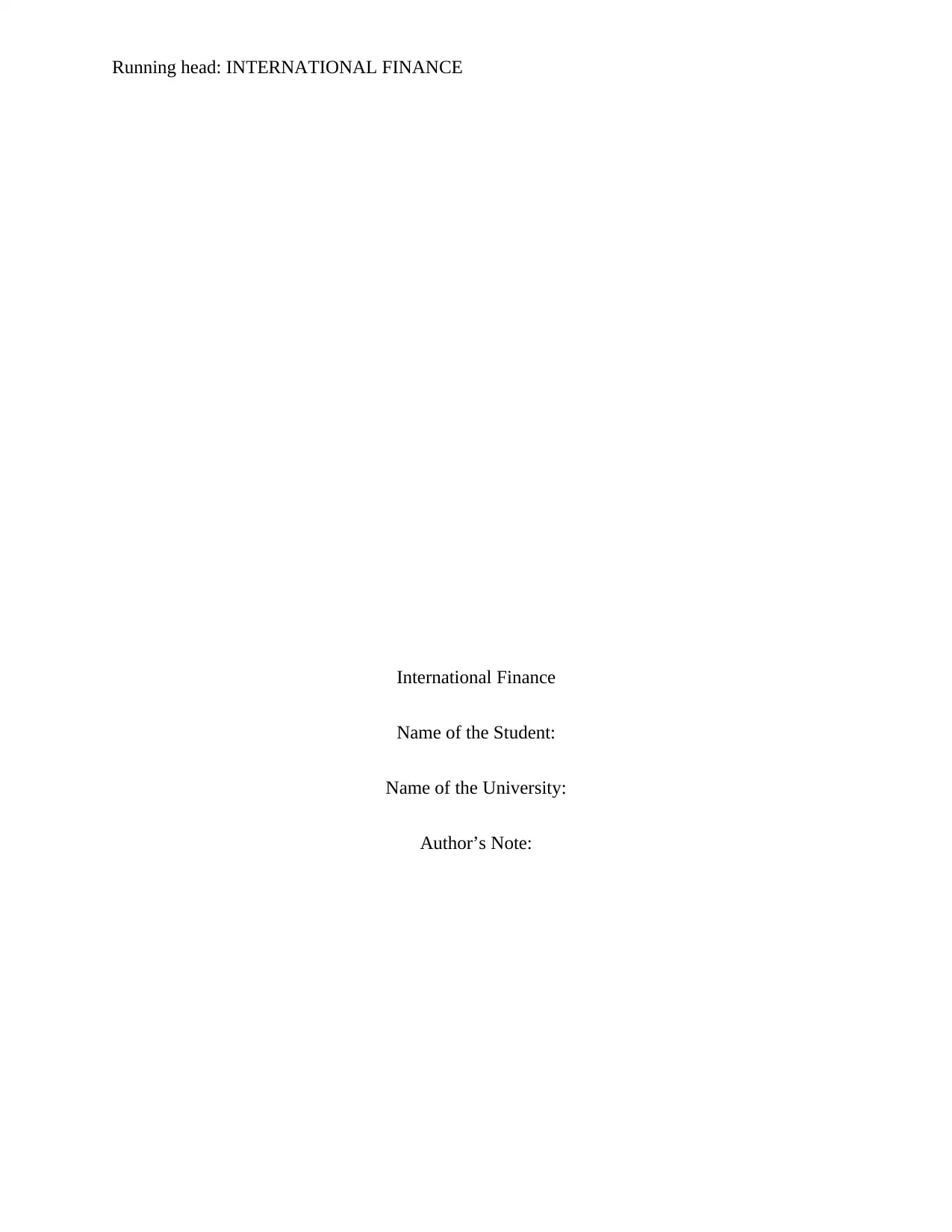
Running head: INTERNATIONAL FINANCE
International Finance
Name of the Student:
Name of the University:
Author’s Note:
International Finance
Name of the Student:
Name of the University:
Author’s Note:
Paraphrase This Document
Need a fresh take? Get an instant paraphrase of this document with our AI Paraphraser
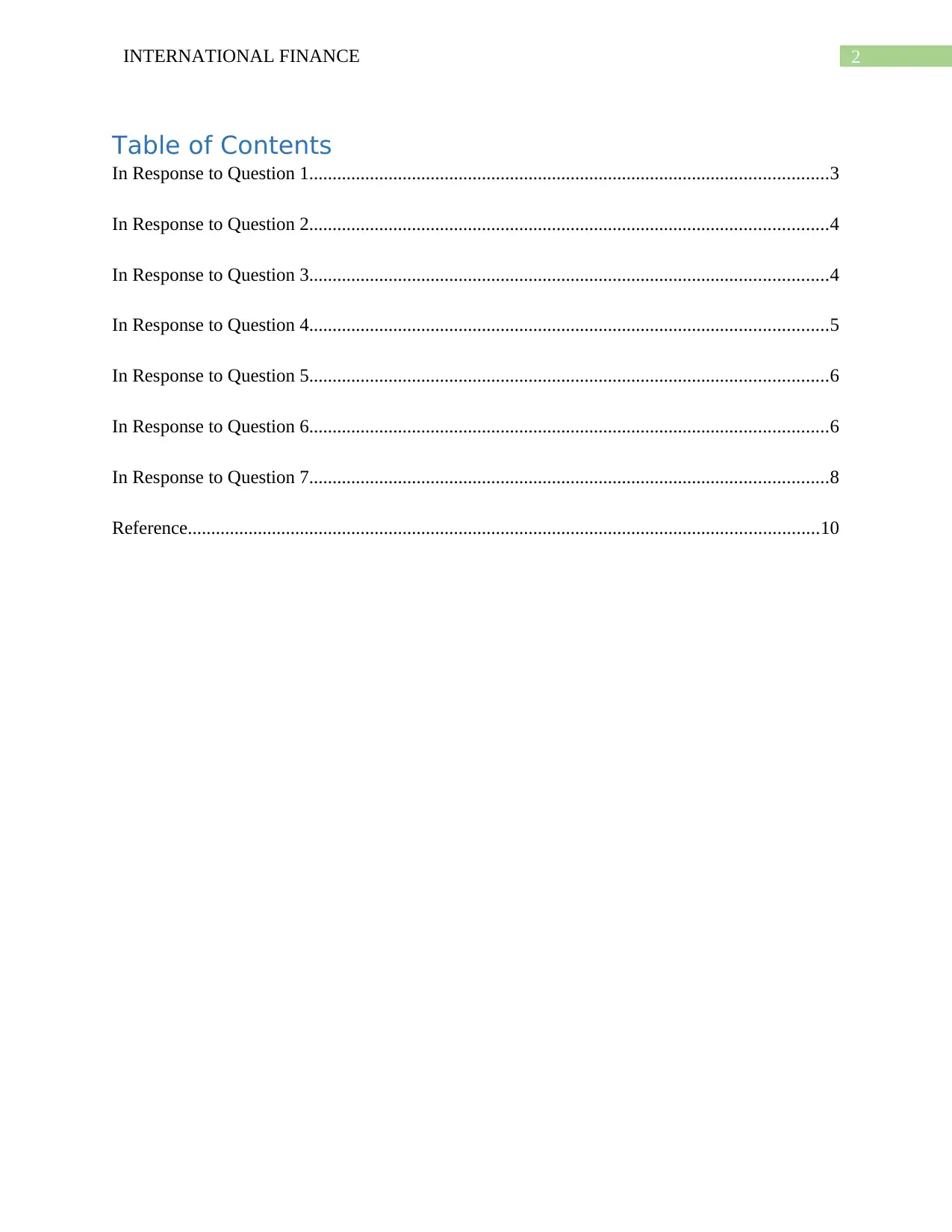
2INTERNATIONAL FINANCE
Table of Contents
In Response to Question 1...............................................................................................................3
In Response to Question 2...............................................................................................................4
In Response to Question 3...............................................................................................................4
In Response to Question 4...............................................................................................................5
In Response to Question 5...............................................................................................................6
In Response to Question 6...............................................................................................................6
In Response to Question 7...............................................................................................................8
Reference.......................................................................................................................................10
Table of Contents
In Response to Question 1...............................................................................................................3
In Response to Question 2...............................................................................................................4
In Response to Question 3...............................................................................................................4
In Response to Question 4...............................................................................................................5
In Response to Question 5...............................................................................................................6
In Response to Question 6...............................................................................................................6
In Response to Question 7...............................................................................................................8
Reference.......................................................................................................................................10
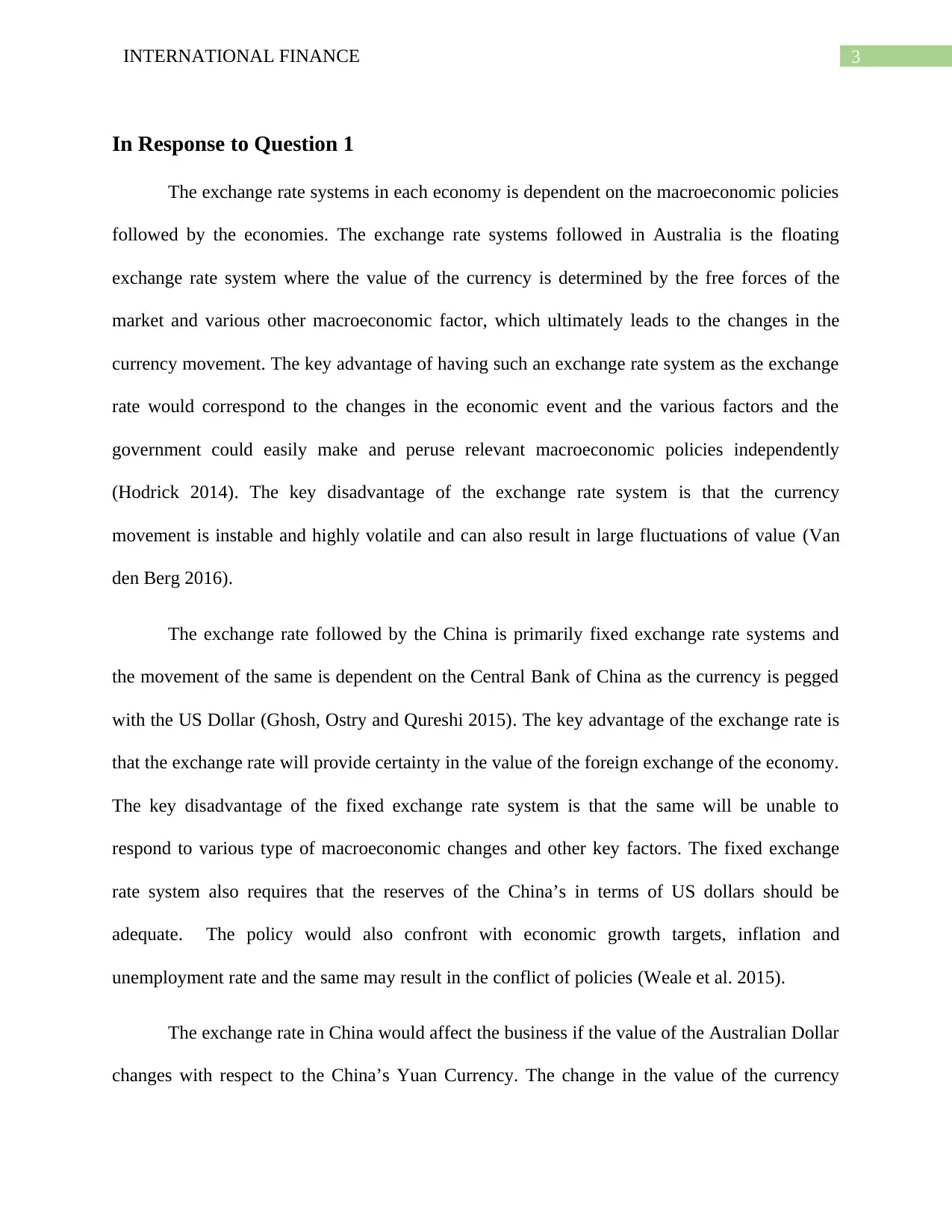
3INTERNATIONAL FINANCE
In Response to Question 1
The exchange rate systems in each economy is dependent on the macroeconomic policies
followed by the economies. The exchange rate systems followed in Australia is the floating
exchange rate system where the value of the currency is determined by the free forces of the
market and various other macroeconomic factor, which ultimately leads to the changes in the
currency movement. The key advantage of having such an exchange rate system as the exchange
rate would correspond to the changes in the economic event and the various factors and the
government could easily make and peruse relevant macroeconomic policies independently
(Hodrick 2014). The key disadvantage of the exchange rate system is that the currency
movement is instable and highly volatile and can also result in large fluctuations of value (Van
den Berg 2016).
The exchange rate followed by the China is primarily fixed exchange rate systems and
the movement of the same is dependent on the Central Bank of China as the currency is pegged
with the US Dollar (Ghosh, Ostry and Qureshi 2015). The key advantage of the exchange rate is
that the exchange rate will provide certainty in the value of the foreign exchange of the economy.
The key disadvantage of the fixed exchange rate system is that the same will be unable to
respond to various type of macroeconomic changes and other key factors. The fixed exchange
rate system also requires that the reserves of the China’s in terms of US dollars should be
adequate. The policy would also confront with economic growth targets, inflation and
unemployment rate and the same may result in the conflict of policies (Weale et al. 2015).
The exchange rate in China would affect the business if the value of the Australian Dollar
changes with respect to the China’s Yuan Currency. The change in the value of the currency
In Response to Question 1
The exchange rate systems in each economy is dependent on the macroeconomic policies
followed by the economies. The exchange rate systems followed in Australia is the floating
exchange rate system where the value of the currency is determined by the free forces of the
market and various other macroeconomic factor, which ultimately leads to the changes in the
currency movement. The key advantage of having such an exchange rate system as the exchange
rate would correspond to the changes in the economic event and the various factors and the
government could easily make and peruse relevant macroeconomic policies independently
(Hodrick 2014). The key disadvantage of the exchange rate system is that the currency
movement is instable and highly volatile and can also result in large fluctuations of value (Van
den Berg 2016).
The exchange rate followed by the China is primarily fixed exchange rate systems and
the movement of the same is dependent on the Central Bank of China as the currency is pegged
with the US Dollar (Ghosh, Ostry and Qureshi 2015). The key advantage of the exchange rate is
that the exchange rate will provide certainty in the value of the foreign exchange of the economy.
The key disadvantage of the fixed exchange rate system is that the same will be unable to
respond to various type of macroeconomic changes and other key factors. The fixed exchange
rate system also requires that the reserves of the China’s in terms of US dollars should be
adequate. The policy would also confront with economic growth targets, inflation and
unemployment rate and the same may result in the conflict of policies (Weale et al. 2015).
The exchange rate in China would affect the business if the value of the Australian Dollar
changes with respect to the China’s Yuan Currency. The change in the value of the currency
⊘ This is a preview!⊘
Do you want full access?
Subscribe today to unlock all pages.

Trusted by 1+ million students worldwide
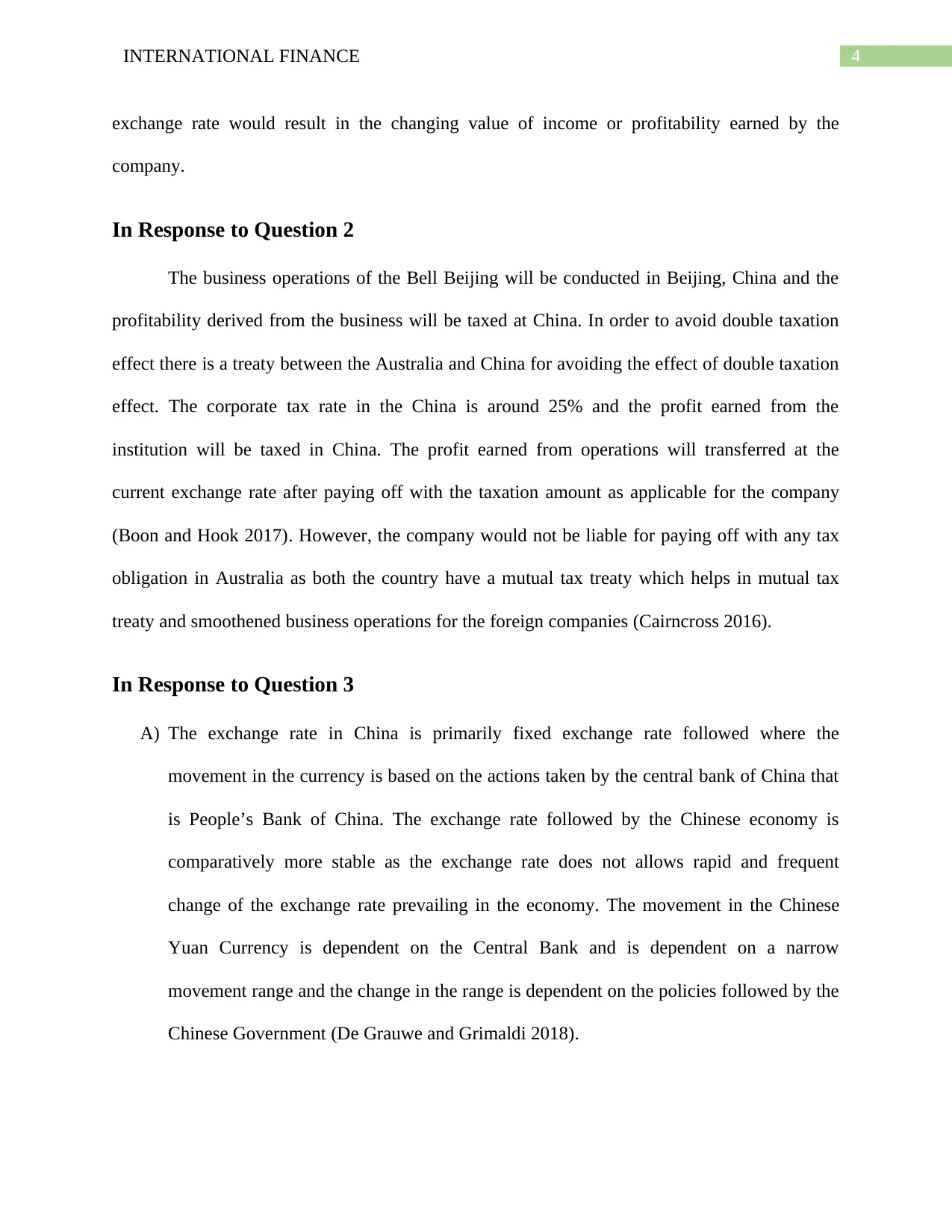
4INTERNATIONAL FINANCE
exchange rate would result in the changing value of income or profitability earned by the
company.
In Response to Question 2
The business operations of the Bell Beijing will be conducted in Beijing, China and the
profitability derived from the business will be taxed at China. In order to avoid double taxation
effect there is a treaty between the Australia and China for avoiding the effect of double taxation
effect. The corporate tax rate in the China is around 25% and the profit earned from the
institution will be taxed in China. The profit earned from operations will transferred at the
current exchange rate after paying off with the taxation amount as applicable for the company
(Boon and Hook 2017). However, the company would not be liable for paying off with any tax
obligation in Australia as both the country have a mutual tax treaty which helps in mutual tax
treaty and smoothened business operations for the foreign companies (Cairncross 2016).
In Response to Question 3
A) The exchange rate in China is primarily fixed exchange rate followed where the
movement in the currency is based on the actions taken by the central bank of China that
is People’s Bank of China. The exchange rate followed by the Chinese economy is
comparatively more stable as the exchange rate does not allows rapid and frequent
change of the exchange rate prevailing in the economy. The movement in the Chinese
Yuan Currency is dependent on the Central Bank and is dependent on a narrow
movement range and the change in the range is dependent on the policies followed by the
Chinese Government (De Grauwe and Grimaldi 2018).
exchange rate would result in the changing value of income or profitability earned by the
company.
In Response to Question 2
The business operations of the Bell Beijing will be conducted in Beijing, China and the
profitability derived from the business will be taxed at China. In order to avoid double taxation
effect there is a treaty between the Australia and China for avoiding the effect of double taxation
effect. The corporate tax rate in the China is around 25% and the profit earned from the
institution will be taxed in China. The profit earned from operations will transferred at the
current exchange rate after paying off with the taxation amount as applicable for the company
(Boon and Hook 2017). However, the company would not be liable for paying off with any tax
obligation in Australia as both the country have a mutual tax treaty which helps in mutual tax
treaty and smoothened business operations for the foreign companies (Cairncross 2016).
In Response to Question 3
A) The exchange rate in China is primarily fixed exchange rate followed where the
movement in the currency is based on the actions taken by the central bank of China that
is People’s Bank of China. The exchange rate followed by the Chinese economy is
comparatively more stable as the exchange rate does not allows rapid and frequent
change of the exchange rate prevailing in the economy. The movement in the Chinese
Yuan Currency is dependent on the Central Bank and is dependent on a narrow
movement range and the change in the range is dependent on the policies followed by the
Chinese Government (De Grauwe and Grimaldi 2018).
Paraphrase This Document
Need a fresh take? Get an instant paraphrase of this document with our AI Paraphraser
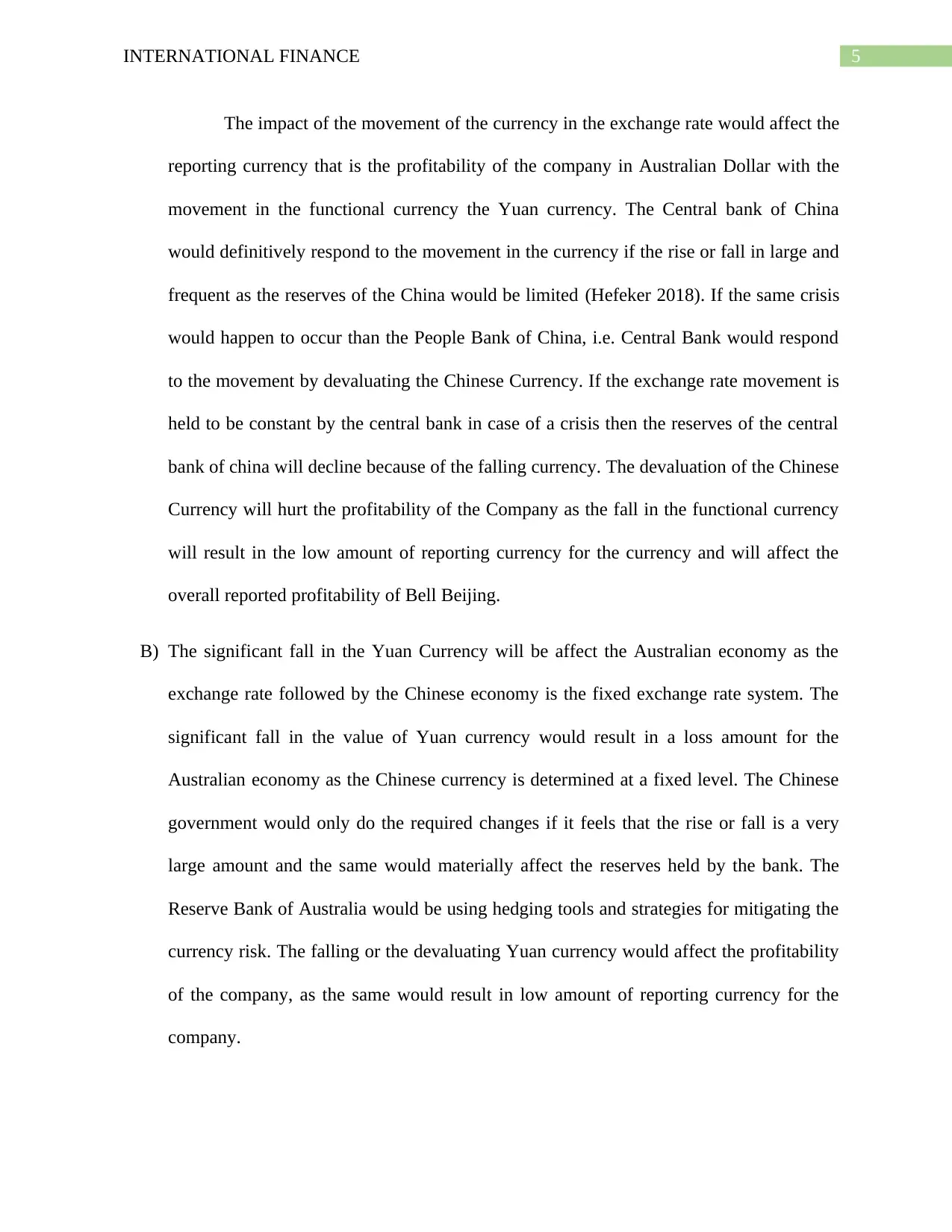
5INTERNATIONAL FINANCE
The impact of the movement of the currency in the exchange rate would affect the
reporting currency that is the profitability of the company in Australian Dollar with the
movement in the functional currency the Yuan currency. The Central bank of China
would definitively respond to the movement in the currency if the rise or fall in large and
frequent as the reserves of the China would be limited (Hefeker 2018). If the same crisis
would happen to occur than the People Bank of China, i.e. Central Bank would respond
to the movement by devaluating the Chinese Currency. If the exchange rate movement is
held to be constant by the central bank in case of a crisis then the reserves of the central
bank of china will decline because of the falling currency. The devaluation of the Chinese
Currency will hurt the profitability of the Company as the fall in the functional currency
will result in the low amount of reporting currency for the currency and will affect the
overall reported profitability of Bell Beijing.
B) The significant fall in the Yuan Currency will be affect the Australian economy as the
exchange rate followed by the Chinese economy is the fixed exchange rate system. The
significant fall in the value of Yuan currency would result in a loss amount for the
Australian economy as the Chinese currency is determined at a fixed level. The Chinese
government would only do the required changes if it feels that the rise or fall is a very
large amount and the same would materially affect the reserves held by the bank. The
Reserve Bank of Australia would be using hedging tools and strategies for mitigating the
currency risk. The falling or the devaluating Yuan currency would affect the profitability
of the company, as the same would result in low amount of reporting currency for the
company.
The impact of the movement of the currency in the exchange rate would affect the
reporting currency that is the profitability of the company in Australian Dollar with the
movement in the functional currency the Yuan currency. The Central bank of China
would definitively respond to the movement in the currency if the rise or fall in large and
frequent as the reserves of the China would be limited (Hefeker 2018). If the same crisis
would happen to occur than the People Bank of China, i.e. Central Bank would respond
to the movement by devaluating the Chinese Currency. If the exchange rate movement is
held to be constant by the central bank in case of a crisis then the reserves of the central
bank of china will decline because of the falling currency. The devaluation of the Chinese
Currency will hurt the profitability of the Company as the fall in the functional currency
will result in the low amount of reporting currency for the currency and will affect the
overall reported profitability of Bell Beijing.
B) The significant fall in the Yuan Currency will be affect the Australian economy as the
exchange rate followed by the Chinese economy is the fixed exchange rate system. The
significant fall in the value of Yuan currency would result in a loss amount for the
Australian economy as the Chinese currency is determined at a fixed level. The Chinese
government would only do the required changes if it feels that the rise or fall is a very
large amount and the same would materially affect the reserves held by the bank. The
Reserve Bank of Australia would be using hedging tools and strategies for mitigating the
currency risk. The falling or the devaluating Yuan currency would affect the profitability
of the company, as the same would result in low amount of reporting currency for the
company.
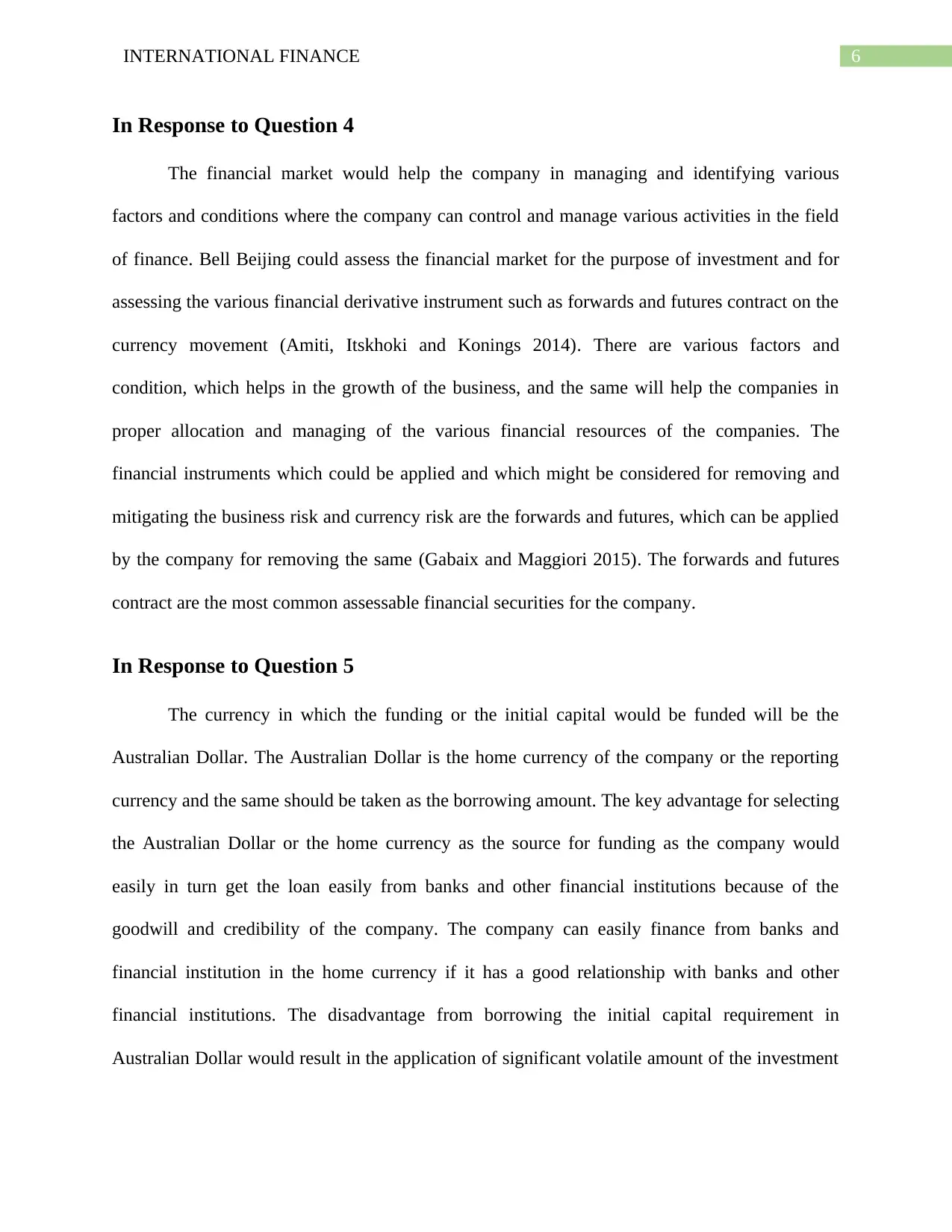
6INTERNATIONAL FINANCE
In Response to Question 4
The financial market would help the company in managing and identifying various
factors and conditions where the company can control and manage various activities in the field
of finance. Bell Beijing could assess the financial market for the purpose of investment and for
assessing the various financial derivative instrument such as forwards and futures contract on the
currency movement (Amiti, Itskhoki and Konings 2014). There are various factors and
condition, which helps in the growth of the business, and the same will help the companies in
proper allocation and managing of the various financial resources of the companies. The
financial instruments which could be applied and which might be considered for removing and
mitigating the business risk and currency risk are the forwards and futures, which can be applied
by the company for removing the same (Gabaix and Maggiori 2015). The forwards and futures
contract are the most common assessable financial securities for the company.
In Response to Question 5
The currency in which the funding or the initial capital would be funded will be the
Australian Dollar. The Australian Dollar is the home currency of the company or the reporting
currency and the same should be taken as the borrowing amount. The key advantage for selecting
the Australian Dollar or the home currency as the source for funding as the company would
easily in turn get the loan easily from banks and other financial institutions because of the
goodwill and credibility of the company. The company can easily finance from banks and
financial institution in the home currency if it has a good relationship with banks and other
financial institutions. The disadvantage from borrowing the initial capital requirement in
Australian Dollar would result in the application of significant volatile amount of the investment
In Response to Question 4
The financial market would help the company in managing and identifying various
factors and conditions where the company can control and manage various activities in the field
of finance. Bell Beijing could assess the financial market for the purpose of investment and for
assessing the various financial derivative instrument such as forwards and futures contract on the
currency movement (Amiti, Itskhoki and Konings 2014). There are various factors and
condition, which helps in the growth of the business, and the same will help the companies in
proper allocation and managing of the various financial resources of the companies. The
financial instruments which could be applied and which might be considered for removing and
mitigating the business risk and currency risk are the forwards and futures, which can be applied
by the company for removing the same (Gabaix and Maggiori 2015). The forwards and futures
contract are the most common assessable financial securities for the company.
In Response to Question 5
The currency in which the funding or the initial capital would be funded will be the
Australian Dollar. The Australian Dollar is the home currency of the company or the reporting
currency and the same should be taken as the borrowing amount. The key advantage for selecting
the Australian Dollar or the home currency as the source for funding as the company would
easily in turn get the loan easily from banks and other financial institutions because of the
goodwill and credibility of the company. The company can easily finance from banks and
financial institution in the home currency if it has a good relationship with banks and other
financial institutions. The disadvantage from borrowing the initial capital requirement in
Australian Dollar would result in the application of significant volatile amount of the investment
⊘ This is a preview!⊘
Do you want full access?
Subscribe today to unlock all pages.

Trusted by 1+ million students worldwide
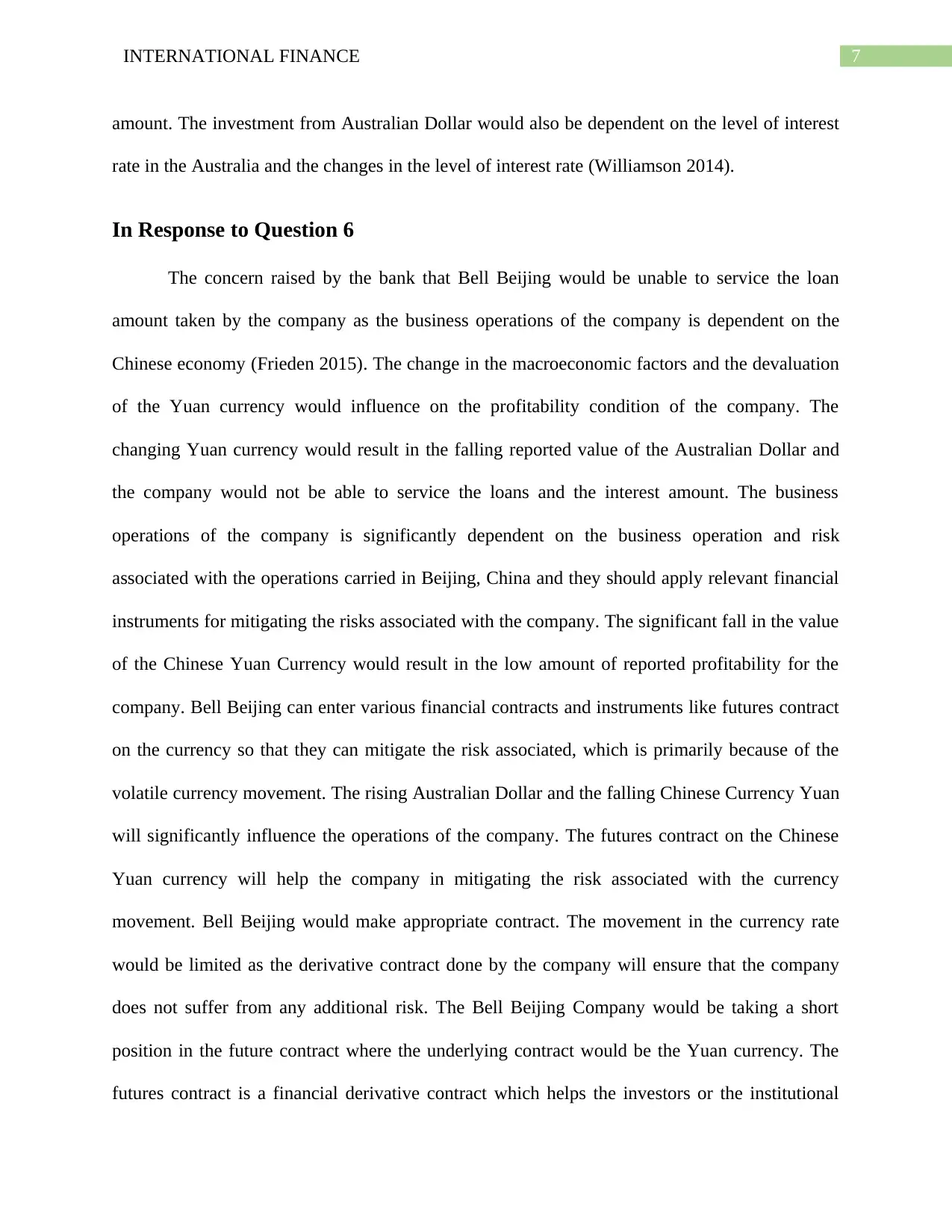
7INTERNATIONAL FINANCE
amount. The investment from Australian Dollar would also be dependent on the level of interest
rate in the Australia and the changes in the level of interest rate (Williamson 2014).
In Response to Question 6
The concern raised by the bank that Bell Beijing would be unable to service the loan
amount taken by the company as the business operations of the company is dependent on the
Chinese economy (Frieden 2015). The change in the macroeconomic factors and the devaluation
of the Yuan currency would influence on the profitability condition of the company. The
changing Yuan currency would result in the falling reported value of the Australian Dollar and
the company would not be able to service the loans and the interest amount. The business
operations of the company is significantly dependent on the business operation and risk
associated with the operations carried in Beijing, China and they should apply relevant financial
instruments for mitigating the risks associated with the company. The significant fall in the value
of the Chinese Yuan Currency would result in the low amount of reported profitability for the
company. Bell Beijing can enter various financial contracts and instruments like futures contract
on the currency so that they can mitigate the risk associated, which is primarily because of the
volatile currency movement. The rising Australian Dollar and the falling Chinese Currency Yuan
will significantly influence the operations of the company. The futures contract on the Chinese
Yuan currency will help the company in mitigating the risk associated with the currency
movement. Bell Beijing would make appropriate contract. The movement in the currency rate
would be limited as the derivative contract done by the company will ensure that the company
does not suffer from any additional risk. The Bell Beijing Company would be taking a short
position in the future contract where the underlying contract would be the Yuan currency. The
futures contract is a financial derivative contract which helps the investors or the institutional
amount. The investment from Australian Dollar would also be dependent on the level of interest
rate in the Australia and the changes in the level of interest rate (Williamson 2014).
In Response to Question 6
The concern raised by the bank that Bell Beijing would be unable to service the loan
amount taken by the company as the business operations of the company is dependent on the
Chinese economy (Frieden 2015). The change in the macroeconomic factors and the devaluation
of the Yuan currency would influence on the profitability condition of the company. The
changing Yuan currency would result in the falling reported value of the Australian Dollar and
the company would not be able to service the loans and the interest amount. The business
operations of the company is significantly dependent on the business operation and risk
associated with the operations carried in Beijing, China and they should apply relevant financial
instruments for mitigating the risks associated with the company. The significant fall in the value
of the Chinese Yuan Currency would result in the low amount of reported profitability for the
company. Bell Beijing can enter various financial contracts and instruments like futures contract
on the currency so that they can mitigate the risk associated, which is primarily because of the
volatile currency movement. The rising Australian Dollar and the falling Chinese Currency Yuan
will significantly influence the operations of the company. The futures contract on the Chinese
Yuan currency will help the company in mitigating the risk associated with the currency
movement. Bell Beijing would make appropriate contract. The movement in the currency rate
would be limited as the derivative contract done by the company will ensure that the company
does not suffer from any additional risk. The Bell Beijing Company would be taking a short
position in the future contract where the underlying contract would be the Yuan currency. The
futures contract is a financial derivative contract which helps the investors or the institutional
Paraphrase This Document
Need a fresh take? Get an instant paraphrase of this document with our AI Paraphraser
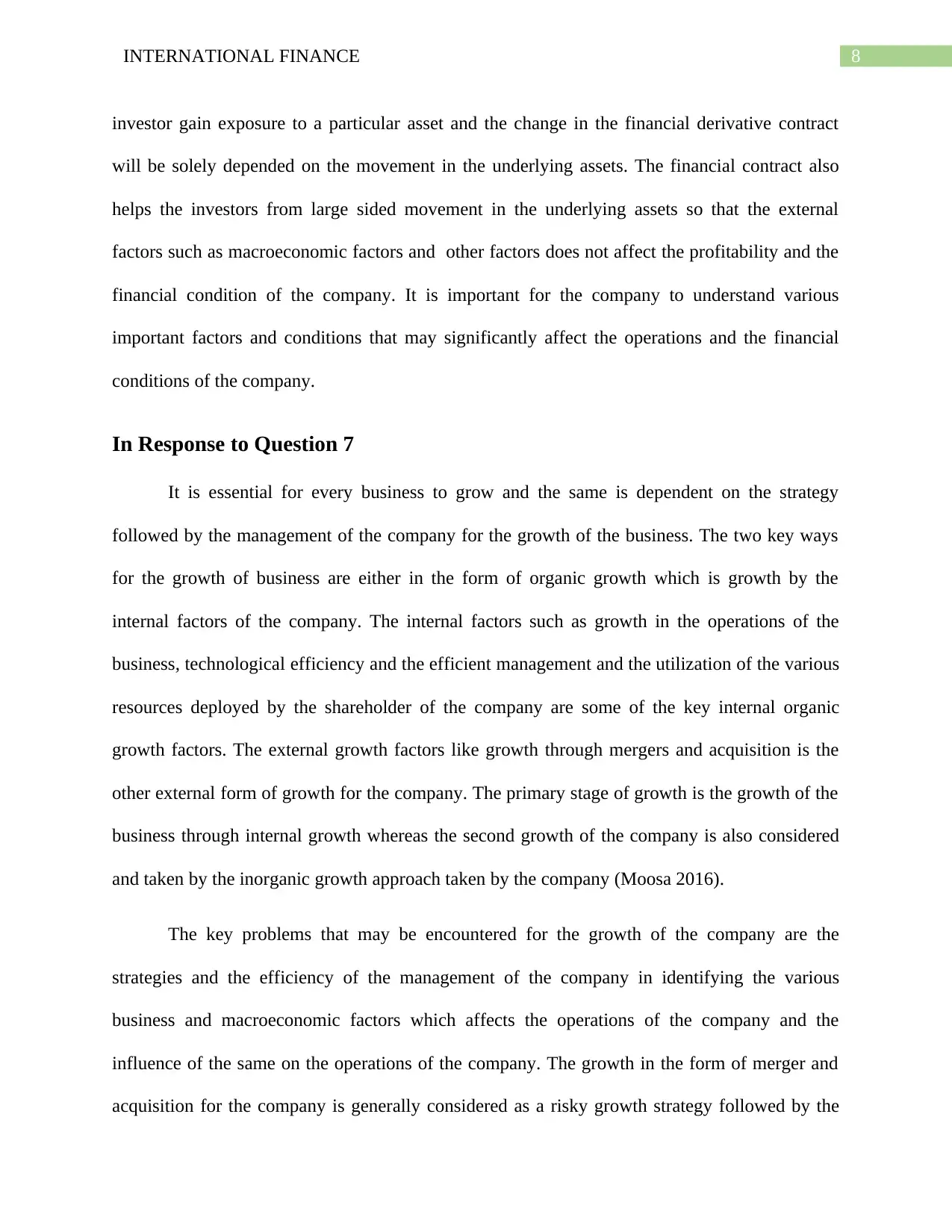
8INTERNATIONAL FINANCE
investor gain exposure to a particular asset and the change in the financial derivative contract
will be solely depended on the movement in the underlying assets. The financial contract also
helps the investors from large sided movement in the underlying assets so that the external
factors such as macroeconomic factors and other factors does not affect the profitability and the
financial condition of the company. It is important for the company to understand various
important factors and conditions that may significantly affect the operations and the financial
conditions of the company.
In Response to Question 7
It is essential for every business to grow and the same is dependent on the strategy
followed by the management of the company for the growth of the business. The two key ways
for the growth of business are either in the form of organic growth which is growth by the
internal factors of the company. The internal factors such as growth in the operations of the
business, technological efficiency and the efficient management and the utilization of the various
resources deployed by the shareholder of the company are some of the key internal organic
growth factors. The external growth factors like growth through mergers and acquisition is the
other external form of growth for the company. The primary stage of growth is the growth of the
business through internal growth whereas the second growth of the company is also considered
and taken by the inorganic growth approach taken by the company (Moosa 2016).
The key problems that may be encountered for the growth of the company are the
strategies and the efficiency of the management of the company in identifying the various
business and macroeconomic factors which affects the operations of the company and the
influence of the same on the operations of the company. The growth in the form of merger and
acquisition for the company is generally considered as a risky growth strategy followed by the
investor gain exposure to a particular asset and the change in the financial derivative contract
will be solely depended on the movement in the underlying assets. The financial contract also
helps the investors from large sided movement in the underlying assets so that the external
factors such as macroeconomic factors and other factors does not affect the profitability and the
financial condition of the company. It is important for the company to understand various
important factors and conditions that may significantly affect the operations and the financial
conditions of the company.
In Response to Question 7
It is essential for every business to grow and the same is dependent on the strategy
followed by the management of the company for the growth of the business. The two key ways
for the growth of business are either in the form of organic growth which is growth by the
internal factors of the company. The internal factors such as growth in the operations of the
business, technological efficiency and the efficient management and the utilization of the various
resources deployed by the shareholder of the company are some of the key internal organic
growth factors. The external growth factors like growth through mergers and acquisition is the
other external form of growth for the company. The primary stage of growth is the growth of the
business through internal growth whereas the second growth of the company is also considered
and taken by the inorganic growth approach taken by the company (Moosa 2016).
The key problems that may be encountered for the growth of the company are the
strategies and the efficiency of the management of the company in identifying the various
business and macroeconomic factors which affects the operations of the company and the
influence of the same on the operations of the company. The growth in the form of merger and
acquisition for the company is generally considered as a risky growth strategy followed by the
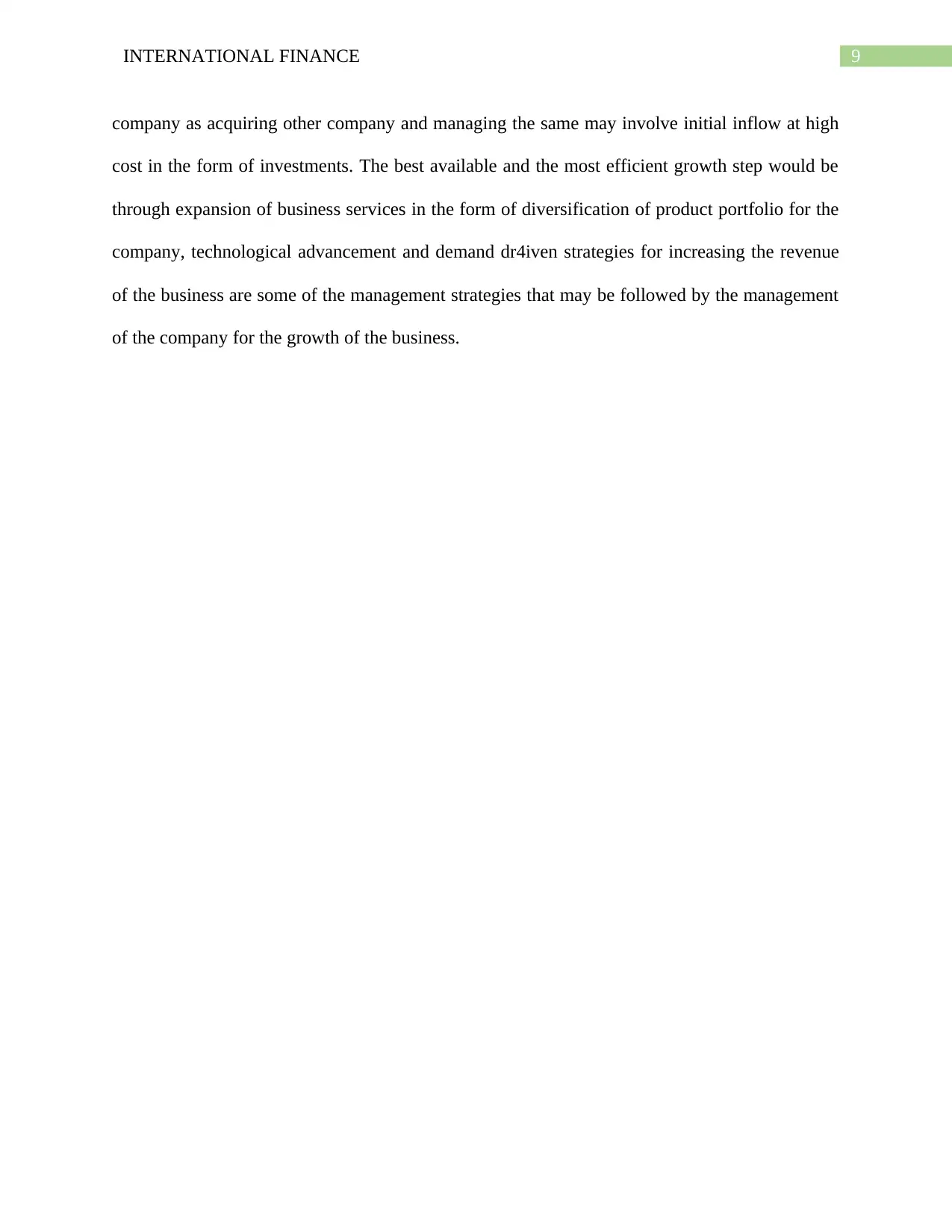
9INTERNATIONAL FINANCE
company as acquiring other company and managing the same may involve initial inflow at high
cost in the form of investments. The best available and the most efficient growth step would be
through expansion of business services in the form of diversification of product portfolio for the
company, technological advancement and demand dr4iven strategies for increasing the revenue
of the business are some of the management strategies that may be followed by the management
of the company for the growth of the business.
company as acquiring other company and managing the same may involve initial inflow at high
cost in the form of investments. The best available and the most efficient growth step would be
through expansion of business services in the form of diversification of product portfolio for the
company, technological advancement and demand dr4iven strategies for increasing the revenue
of the business are some of the management strategies that may be followed by the management
of the company for the growth of the business.
⊘ This is a preview!⊘
Do you want full access?
Subscribe today to unlock all pages.

Trusted by 1+ million students worldwide
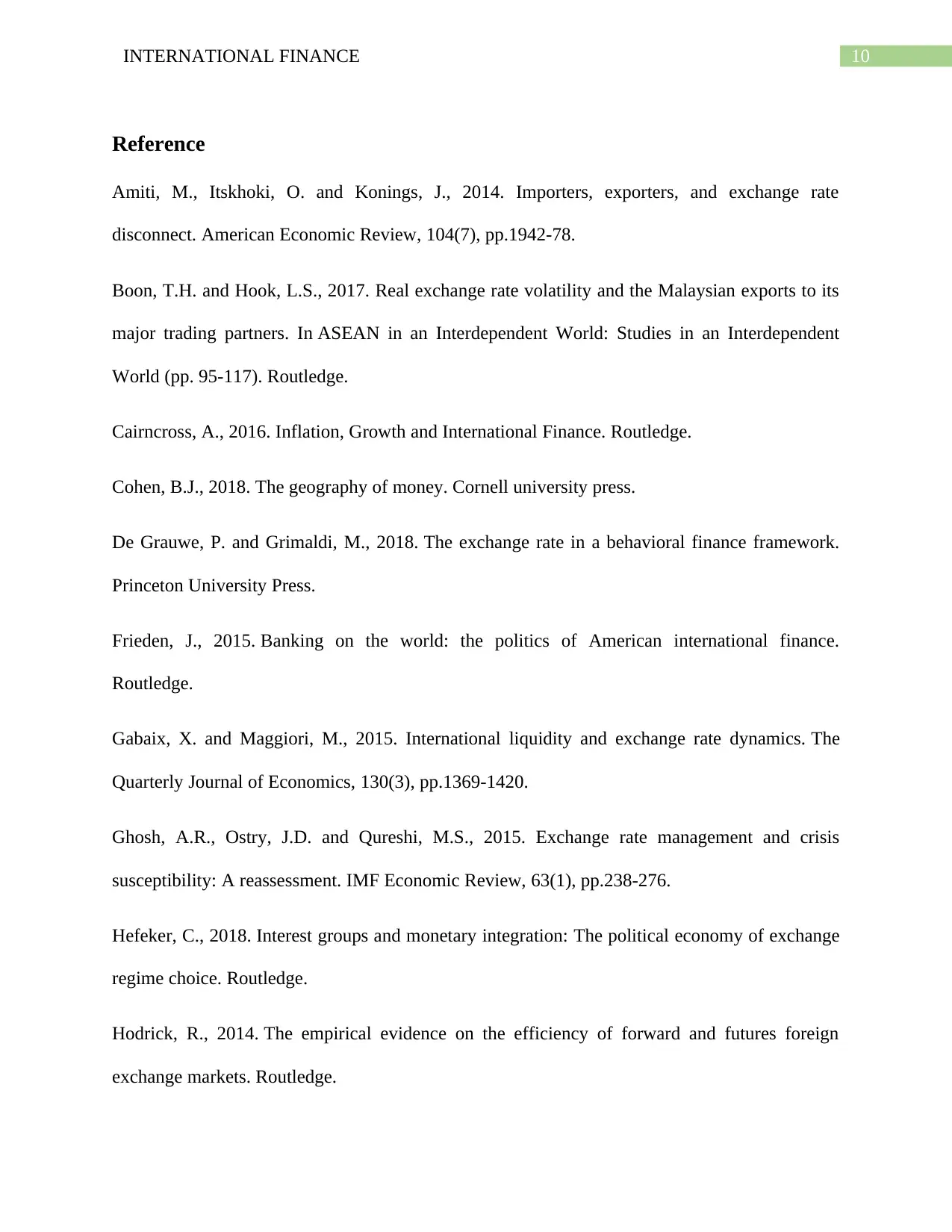
10INTERNATIONAL FINANCE
Reference
Amiti, M., Itskhoki, O. and Konings, J., 2014. Importers, exporters, and exchange rate
disconnect. American Economic Review, 104(7), pp.1942-78.
Boon, T.H. and Hook, L.S., 2017. Real exchange rate volatility and the Malaysian exports to its
major trading partners. In ASEAN in an Interdependent World: Studies in an Interdependent
World (pp. 95-117). Routledge.
Cairncross, A., 2016. Inflation, Growth and International Finance. Routledge.
Cohen, B.J., 2018. The geography of money. Cornell university press.
De Grauwe, P. and Grimaldi, M., 2018. The exchange rate in a behavioral finance framework.
Princeton University Press.
Frieden, J., 2015. Banking on the world: the politics of American international finance.
Routledge.
Gabaix, X. and Maggiori, M., 2015. International liquidity and exchange rate dynamics. The
Quarterly Journal of Economics, 130(3), pp.1369-1420.
Ghosh, A.R., Ostry, J.D. and Qureshi, M.S., 2015. Exchange rate management and crisis
susceptibility: A reassessment. IMF Economic Review, 63(1), pp.238-276.
Hefeker, C., 2018. Interest groups and monetary integration: The political economy of exchange
regime choice. Routledge.
Hodrick, R., 2014. The empirical evidence on the efficiency of forward and futures foreign
exchange markets. Routledge.
Reference
Amiti, M., Itskhoki, O. and Konings, J., 2014. Importers, exporters, and exchange rate
disconnect. American Economic Review, 104(7), pp.1942-78.
Boon, T.H. and Hook, L.S., 2017. Real exchange rate volatility and the Malaysian exports to its
major trading partners. In ASEAN in an Interdependent World: Studies in an Interdependent
World (pp. 95-117). Routledge.
Cairncross, A., 2016. Inflation, Growth and International Finance. Routledge.
Cohen, B.J., 2018. The geography of money. Cornell university press.
De Grauwe, P. and Grimaldi, M., 2018. The exchange rate in a behavioral finance framework.
Princeton University Press.
Frieden, J., 2015. Banking on the world: the politics of American international finance.
Routledge.
Gabaix, X. and Maggiori, M., 2015. International liquidity and exchange rate dynamics. The
Quarterly Journal of Economics, 130(3), pp.1369-1420.
Ghosh, A.R., Ostry, J.D. and Qureshi, M.S., 2015. Exchange rate management and crisis
susceptibility: A reassessment. IMF Economic Review, 63(1), pp.238-276.
Hefeker, C., 2018. Interest groups and monetary integration: The political economy of exchange
regime choice. Routledge.
Hodrick, R., 2014. The empirical evidence on the efficiency of forward and futures foreign
exchange markets. Routledge.
Paraphrase This Document
Need a fresh take? Get an instant paraphrase of this document with our AI Paraphraser
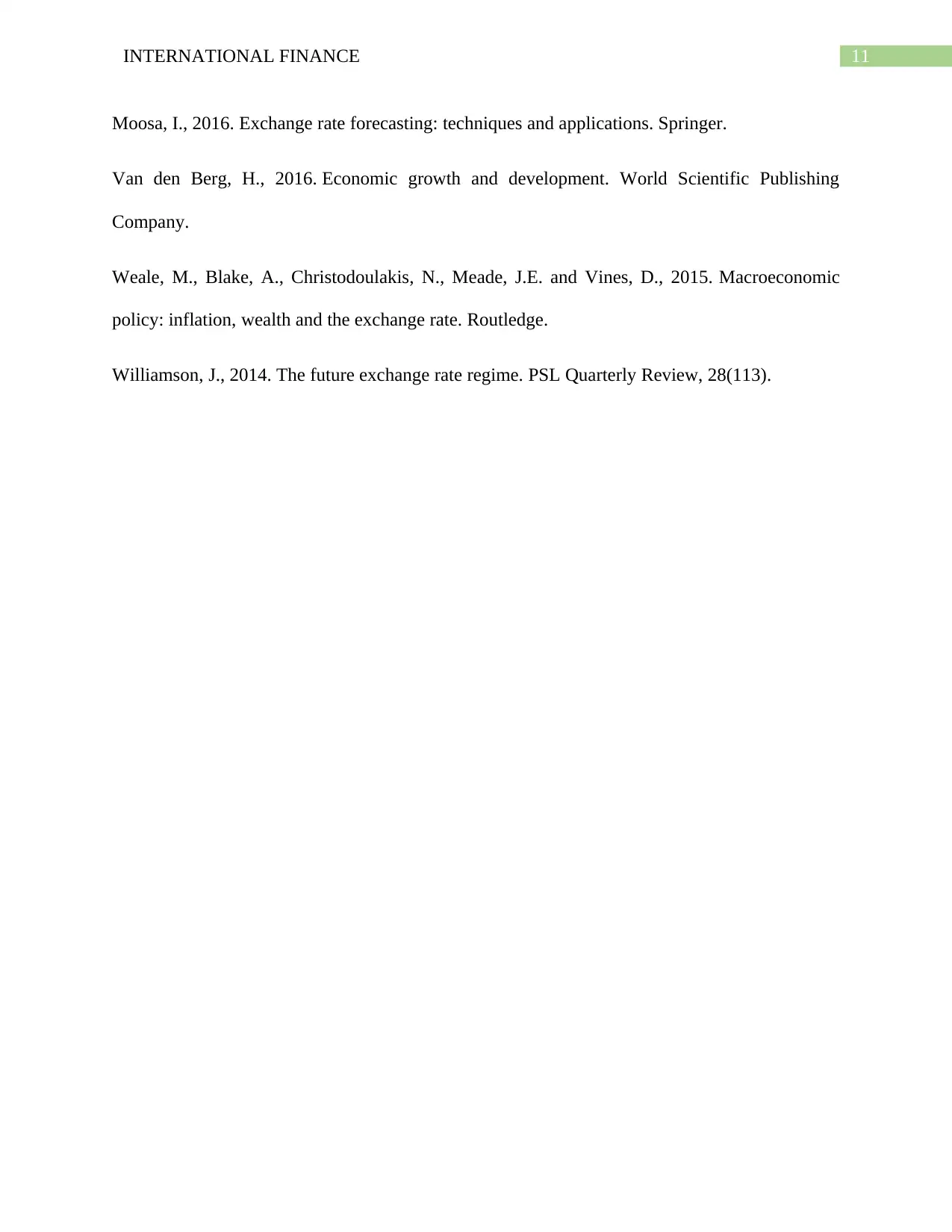
11INTERNATIONAL FINANCE
Moosa, I., 2016. Exchange rate forecasting: techniques and applications. Springer.
Van den Berg, H., 2016. Economic growth and development. World Scientific Publishing
Company.
Weale, M., Blake, A., Christodoulakis, N., Meade, J.E. and Vines, D., 2015. Macroeconomic
policy: inflation, wealth and the exchange rate. Routledge.
Williamson, J., 2014. The future exchange rate regime. PSL Quarterly Review, 28(113).
Moosa, I., 2016. Exchange rate forecasting: techniques and applications. Springer.
Van den Berg, H., 2016. Economic growth and development. World Scientific Publishing
Company.
Weale, M., Blake, A., Christodoulakis, N., Meade, J.E. and Vines, D., 2015. Macroeconomic
policy: inflation, wealth and the exchange rate. Routledge.
Williamson, J., 2014. The future exchange rate regime. PSL Quarterly Review, 28(113).
1 out of 11
Related Documents
Your All-in-One AI-Powered Toolkit for Academic Success.
+13062052269
info@desklib.com
Available 24*7 on WhatsApp / Email
![[object Object]](/_next/static/media/star-bottom.7253800d.svg)
Unlock your academic potential
Copyright © 2020–2025 A2Z Services. All Rights Reserved. Developed and managed by ZUCOL.





